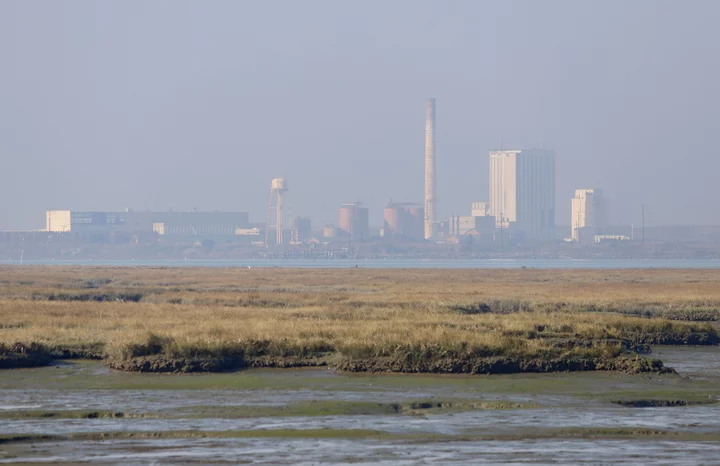A hazy view of the old Samoa Pulp Mill across Humboldt Bay. Photo: Andrew Goff
###
Coastal residents woke up to smoky skies this morning, the result of numerous fires burning across Northern California and Southern Oregon.
Northern winds are pushing smoke down along the coast and onshore from the Anvil Fire, near Port Orford, Oregon, bringing modern to unhealthy air quality conditions throughout Humboldt County. “Overall, smoke will continue to impact inland river valleys with smoke from northerly winds, while coastal areas will see similar conditions with periods of smoke with improvement into the weekend,” according to the North Coast Unified Air Quality Management District.
Sensitive groups – including people with heart or lung disease, older adults, children, and pregnant people – should stay indoors in a place with clean indoor air and keep activity levels light. All others should limit prolonged or heavy activity and time spent outdoors.
###
Press release from the North Coast Unified Air Quality Management District:
The Six Rivers Forest (SRF) Lightning Complex, Smith River Complex, and the Happy Camp Complex remain active generating smoke in the region. Coastal communities will continue to see diminished air quality again today as north winds push smoke from southern Oregon down along the coast and onshore, bringing periods of Moderate to Unhealthy air quality. Communities within the Klamath River Valley should have generally USG conditions and will continue to see more smoke impacts along the river corridor. Communities along the Trinity River Valley will have overall USG conditions throughout the day with increased smoke later in the day. Overall, smoke will continue to impact inland river valleys with smoke from northerly winds, while coastal areas will see similar conditions with periods of smoke with improvement into the weekend.
USFS Air Resource Advisors (ARAs) are assigned to certain fires impacting our area and daily Smoke Outlook Forecasts on one or more of these fires (https://outlooks.wildlandfiresmoke.net/outlook). Air quality monitors and the current Air Quality Index (AQI) should be viewed on the EPA Fire & Smoke Map at https://fire.airnow.gov.
Air quality monitors and the current Air Quality Index (AQI) for communities should be viewed at https://fire.airnow.gov. Additional Particulate Matter (PM2.5) monitors have been deployed in Eureka, Crescent City, Hoopa, Willow Creek, Klamath, Weaverville, Orleans, Hayfork, and Mad River.
Regional Smoke Outlooks – Good , Moderate , to Unhealthy for Sensitive Groups (USG) (AQI 0-150 range):
Humboldt County:
- Eureka area (including Scotia to Trinidad) – Overall Moderate, with periods of USG
- Weitchpec – Overall USG, with Unhealthy in the afternoon
- Hoopa – Overall USG, with periods of heavier smoke in the afternoon/evening
- Willow Creek – Overall USG, with periods of heavier smoke in the afternoon
- Orick – Overall USG
- Garberville, Redway – Overall Moderate, with periods of USG to Unhealthy
Del Norte County:
- Crescent City – Overall USG, with varying periods of smoke from southern Oregon
- Klamath – Overall USG, with periods of Unhealthy in the evening/overnight
- Gasquet – Overall Moderate, with periods of heavier smoke possible
Trinity County:
- Weaverville area – Overall USG, with periods of Unhealthy
- Hayfork – Overall USG, with periods of Unhealthy
- Trinity Center – Overall Moderate, with periods of increased smoke
- Burnt Ranch – Overall USG, with periods of Unhealthy
- Hyampom – Overall USG, with periods of Unhealthy
USFS Air Resource Advisors (ARAs) are assigned to certain fires impacting our area and are providing daily Smoke Outlook Forecasts on one or more of these fires (https://outlooks.wildlandfiresmoke.net/outlook).
Fire information can be found at http://inciweb.nwcg.gov/ or https://fire.airnow.gov/ or app.watchduty.org. Current weather information can be found at www.wrh.noaa.gov. As with all wildfires, ash fallout is possible. Ash fallout information can be found in the Wildfire Smoke Resources section of our webpage at www.ncuaqmd.org.
Health Information & Actions to Protect Yourself from Smoke Impacts
Concentrations of smoke may vary depending upon location, weather, and distance from the fire. Smoke from wildfires and structure fires contain harmful chemicals that can affect your health. Smoke can cause eye and throat irritation, coughing, and difficulty breathing. People who are at greatest risk of experiencing symptoms due to smoke include: those with respiratory disease (such as asthma), those with heart disease, young children, and older adults.
These sensitive populations should stay indoors and avoid prolonged activity. All others should limit prolonged or heavy activity and time spent outdoors. Even healthy adults can be affected by smoke. Seek medical help if you have symptoms that worsen or become severe.
Follow these general precautions to protect your health during a smoke event:
- Minimize or stop outdoor activities, especially exercise.
- Stay indoors with windows and doors closed as much as possible.
- Do not run fans that bring smoky outdoor air inside – examples include swamp coolers, whole-house fans, and fresh air ventilation systems.
- Run your air-conditioner only if it does not bring smoke in from the outdoors. Change the standard air conditioner filter to a medium or high efficiency filter. If available, use the “re-circulate” or “recycle” setting on the unit.
- Do not smoke, fry food, or do other things that will create indoor air pollution. Consider leaving the area until smoke conditions improve if you have repeated coughing, shortness of breath, difficulty breathing, wheezing, chest tightness or pain, palpitations, nausea, unusual fatigue, lightheadedness.
Consider leaving the area until smoke conditions improve if you have repeated coughing, shortness of breath, difficulty breathing, wheezing, chest tightness or pain, palpitations, nausea, unusual fatigue, lightheadedness.
For further information, visit the District’s website at www.ncuaqmd.org or call the District’s Wildfire Response Coordinator at (707) 443-3093 x122.


CLICK TO MANAGE